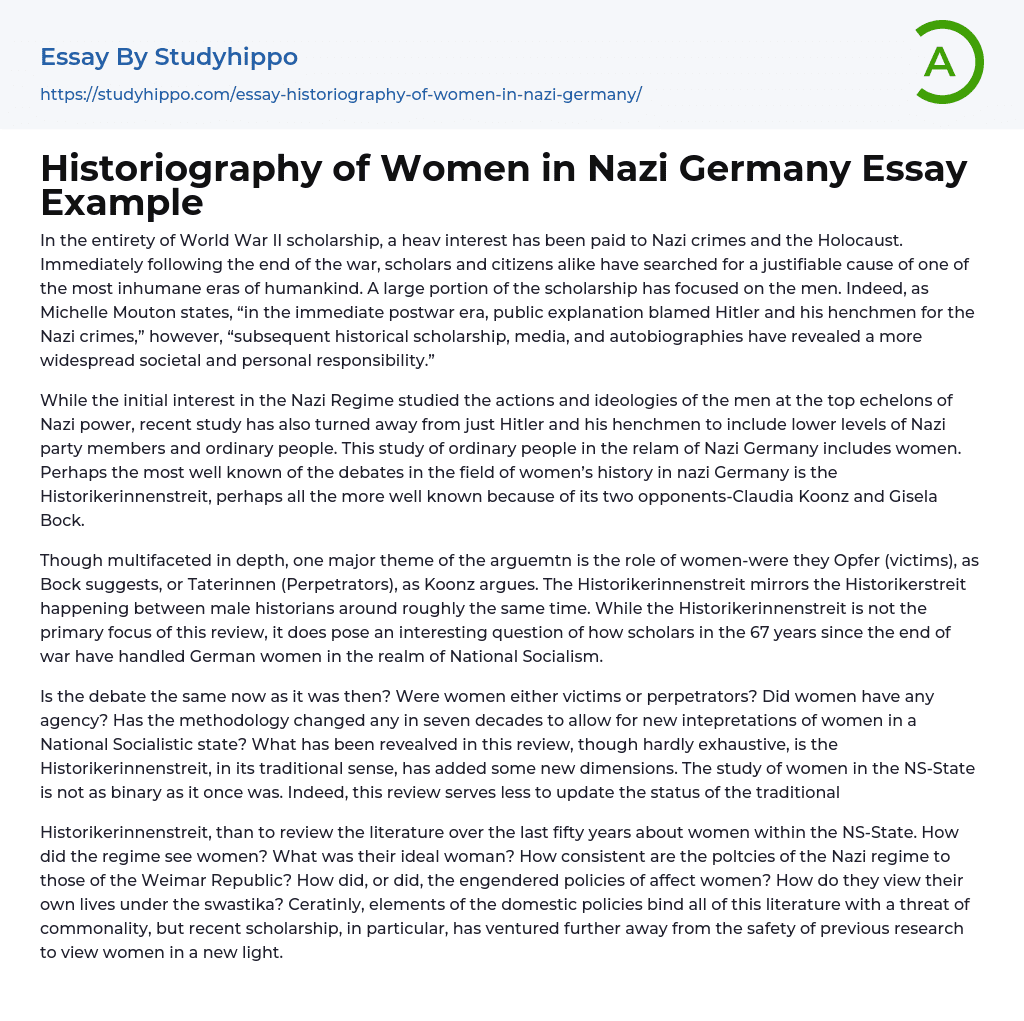In the entirety of World War II scholarship, a heav interest has been paid to Nazi crimes and the Holocaust. Immediately following the end of the war, scholars and citizens alike have searched for a justifiable cause of one of the most inhumane eras of humankind. A large portion of the scholarship has focused on the men. Indeed, as Michelle Mouton states, “in the immediate postwar era, public explanation blamed Hitler and his henchmen for the Nazi crimes,” however, “subsequent historical scholarship, media, and autobiographies have revealed a more widespread societal and personal responsibility.”
While the initial interest in the Nazi Regime studied the actions and ideologies of the men at the top echelons of Nazi power, recent study has also turned away from just Hitler and his henchmen to include lower levels of Nazi party me
...mbers and ordinary people. This study of ordinary people in the relam of Nazi Germany includes women. Perhaps the most well known of the debates in the field of women’s history in nazi Germany is the Historikerinnenstreit, perhaps all the more well known because of its two opponents-Claudia Koonz and Gisela Bock.
Though multifaceted in depth, one major theme of the arguemtn is the role of women-were they Opfer (victims), as Bock suggests, or Taterinnen (Perpetrators), as Koonz argues. The Historikerinnenstreit mirrors the Historikerstreit happening between male historians around roughly the same time. While the Historikerinnenstreit is not the primary focus of this review, it does pose an interesting question of how scholars in the 67 years since the end of war have handled German women in the realm of National Socialism.
Is the
debate the same now as it was then? Were women either victims or perpetrators? Did women have any agency? Has the methodology changed any in seven decades to allow for new intepretations of women in a National Socialistic state? What has been revealved in this review, though hardly exhaustive, is the Historikerinnenstreit, in its traditional sense, has added some new dimensions. The study of women in the NS-State is not as binary as it once was. Indeed, this review serves less to update the status of the traditional
Historikerinnenstreit, than to review the literature over the last fifty years about women within the NS-State. How did the regime see women? What was their ideal woman? How consistent are the poltcies of the Nazi regime to those of the Weimar Republic? How did, or did, the engendered policies of affect women? How do they view their own lives under the swastika? Ceratinly, elements of the domestic policies bind all of this literature with a threat of commonality, but recent scholarship, in particular, has ventured further away from the safety of previous research to view women in a new light.
- Elie Wiesel essays
- Nazi Party essays
- Weimar Republic essays
- Holocaust essays
- Adolf Hitler essays
- Concentration Camps essays
- Anne Frank essays
- African American essays
- African American Culture essays
- American Values essays
- Asian American essays
- Chinese essays
- Ethnicity essays
- Ethnocentrism essays
- German essays
- Han Chinese essays
- Hispanic essays
- Identity essays
- Korean essays
- Mexican essays
- Nation essays
- Native American essays
- Race and Ethnicity essays
- White People essays
- Athens essays
- Belgium essays
- Berlin essays
- British essays
- England essays
- Germany essays
- Great britain essays
- Greece essays
- Ireland essays
- Italy essays
- London essays
- Paris essays
- Pompeii essays
- Rome essays
- Russia essays
- Spain essays
- United Kingdom essays
- 1920S essays
- 1950S essays
- 1960S essays
- 19Th Century essays
- 20Th Century essays
- Ancient Greece essays
- Bravery essays
- British Empire essays
- Civilization essays




